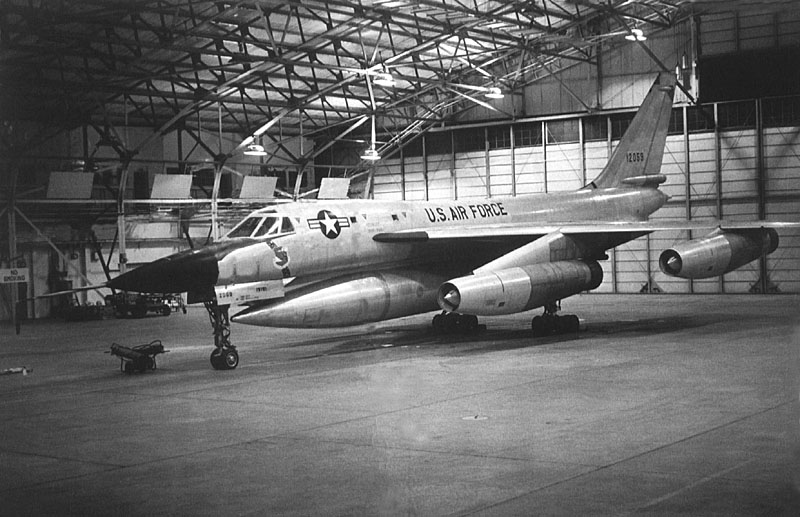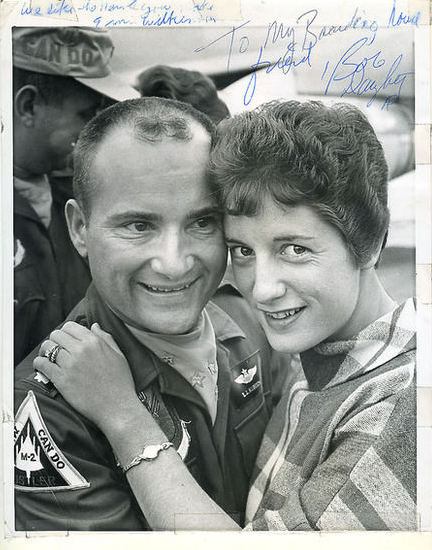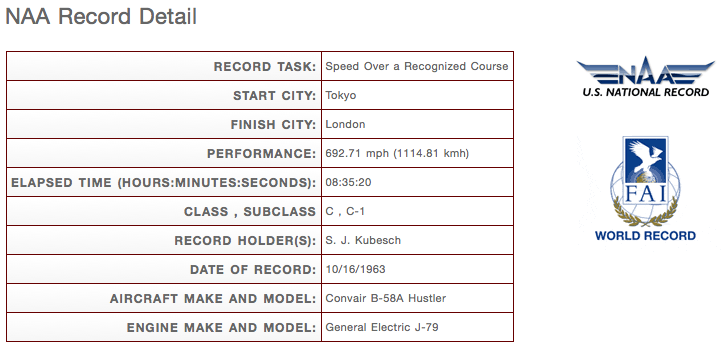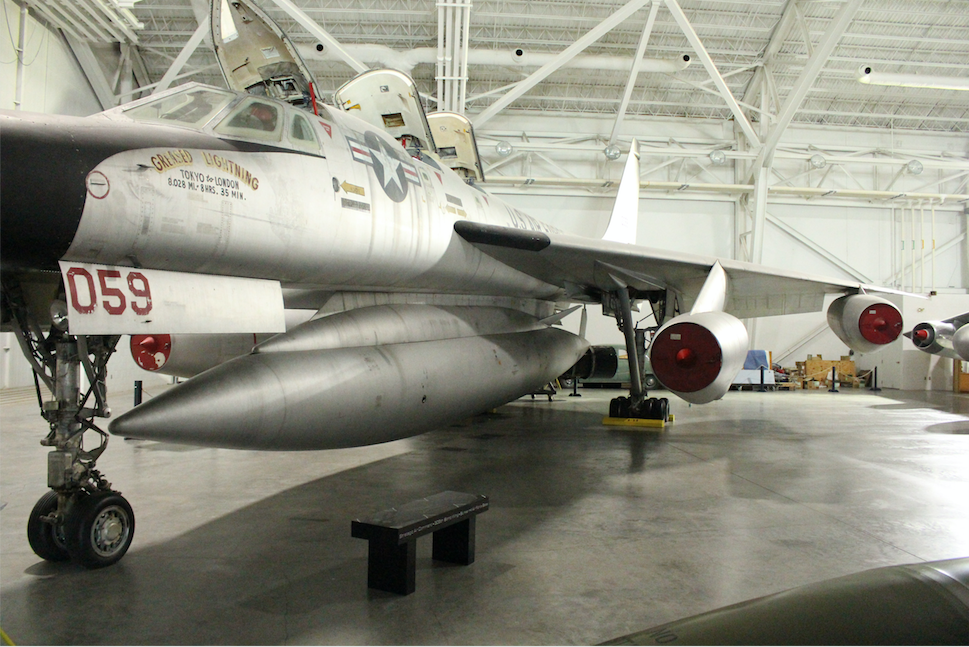

16 October 1963: Operation Greased Lightning. Major Sidney J. Kubesch, Major John Barrett and Captain Gerard Williamson flew from Tokyo, Japan, to London, England, non-stop, in 8 hours, 35 minutes, 20.4 seconds. Their airplane was a Convair B-58A-20-CF Hustler, serial number 61-2059, named Greased Lightning. It was assigned to the 305th Bombardment Wing, 19th Air Division, at Bunker Hill Air Force Base, Indiana.
Five inflight refuelings were required to complete the flight. The bomber had to slow from its supersonic cruise to rendezvous with the tankers. The B-58’s average speed was 692.71 miles per hour (1,114.81 kilometers per hour). The time from Tokyo to Anchorage, Alaska was 3 hours, 9 minutes, 42 seconds at an average speed of 1,093.4 miles per hour (1,759.7 kilometers per hour); and Anchorage to London, 5 hours, 24 minutes, 54 seconds at 826.9 miles per hour (1.330.8 kilometers per hour).
Greased Lightning‘s speed record still stands.


The B-58 Hustler was a high-altitude Mach 2 strategic bomber which served with the United States Air Force from 1960 to 1970. It was crewed by a pilot, navigator/bombardier and a defensive systems operator located in individual cockpits. The aircraft is a delta-winged configuration similar to the Convair F-102A Delta Dagger and F-106 Delta Dart supersonic interceptors.
The Hustler is 96 feet, 10 inches (29.515 meters) long, with a wing span of 56 feet, 10 inches (17.323 meters) and an overall height of 31 feet 5 inches (9.576 meters). The wing’s leading edge is swept back at a 60° angle and the fuselage incorporates the “area rule” which resulted in a “wasp waist” or “Coke bottle” shape for a significant reduction in aerodynamic drag. The airplane’s only control surfaces are two “elevons” and a rudder, and there are no flaps.
The B-58A was powered by four General Electric J79-GE-5 axial-flow afterburning turbojet engines, suspended under the wings from pylons. This was a single-shaft engine with a 17-stage compressor and 3-stage turbine, rated at 10,300 pounds of thrust (45.82 kilonewtons), and 15,600 pounds (69.39 kilonewtons) with afterburner. The J79-GE-5 was 16 feet, 10.2 inches (5.136 meters) long and 3 feet, 2.0 inches (0.965 meters) in diameter.
The bomber had a cruise speed of 610 miles per hour (981.7 kilometers per hour) and a maximum speed of 1,325 miles per hour (2,132.4 kilometers per hour). The service ceiling is 64,800 feet (19,751 meters). Unrefueled range is 4,400 miles (7,081 kilometers). Maximum weight is 168,000 pounds (76,203.5 kilograms).
The B-58 weapons load was a combination of a W-39 warhead, and/or Mk.43 or B61 nuclear bombs. The W-39 warhead, the same used with the Redstone IRBM or Snark cruise missile, was carried in a jettisonable centerline pod, which also carried fuel for the aircraft. The smaller bombs were carried on underwing hardpoints. For defense, there was a General Electric M61 Vulcan 20×102 mm six-barreled rotary cannon mounted in the tail, with 1,200 rounds of linked ammunition, controlled by the Defensive Systems Officer.
Convair B-58A-20 CF 61-2059 is in the collection of the Strategic Air and Space Museum, Ashland, Nebraska.

© 2017, Bryan R. Swopes
Brian, The photo caption is a little off. Can Do is the motto of the 305th. Greased Lightning, as the text states, is the name of the aircraft. Great blog! Keep up the fantastic work. I routinely share your stuff with the faculty at Air Command and Staff College and it often gets used in class in one form or another. John
Thanks, John. That was what I intended to say, but apparently I confused myself. I very much appreciate your visiting and sharing “This Day in Aviation.” It is an honor.
I believe your narrative should say, “Flight time, Tokyo to Anchorage was … at a speed of …”. I enjoy reading your history posts.
Rather clumsy wording, I agree. I changed it around a bit. Thanks, Tome.
I love your blog posts. My Dad flew or worked on virtually all of those aircraft 1942-1984. I grew up seeing and visiting them all. Brings back great memories.
Bryan,
I was looking at a globe and trying to figure the route “Greased Lightning” took from Tokyo to London. Why is there a reference to Anchorage? Was there a stop there, or just an overflight? And why is there a 277 mph difference in the airspeed on the two legs?
Thanks for the posts. I really enjoy them.
Willy, I assume that Greased Lightning flew a Great Circle Course. The most direct route would have taken the B-58 across the Peoples Republic of China and the Union of Soviet Socialist Republics—not a great option for an American strategic bomber. Breaking the flight into two segments—Tokyo to Anchorage, then Anchorage to London—allows the bomber to fly Great Circle courses while staying clear of those countries. Both segments are “recognized courses,” which is the type record for which the bomber qualified. The speed difference is likely related to (a.) the Jet Stream, and (b.) the number of times the B-58 had to slow down for air-to-air refueling on each segment.
Per Wikipedia “ although one of the afterburners malfunctioned and the last hour of the flight was continued at subsonic speed. This reduced the average speed to roughly Mach 1.5, despite most of the flight being at Mach 2”
Brian, Sidney Kubesch is my father. In this video he explains more about the flight: https://www.facebook.com/GrissomAirMuseum/videos/811443572591640/
Thank you, Maryalice! The absolute best thing about writing TDiA is when I hear from someone with a personal relationship to the subject of an article, a child, or grandchild, especially. You made my day!
Dad turned 90 in April and has difficulty speaking. I’m proud to have preserved his talk on the historic flight!
An additional video features Jerry Williamson telling his story: https://www.facebook.com/GrissomAirMuseum/videos/460124201187961/
I loved working in the 43rd BMW at Little Rock. It was a sad day when the Hustlers started leaving for the boneyard. The base got much quiter, though. Nothing says “LOUD” like a Hustler running up its engines!
I was stationed at Bunker Hill AFB from June 1964 to Nov. 1966. The motto of the 305th Bomb Wing was, “Mach 2, Can Do”. I am an enthusiastic fan of the B-58.
Hi – how is it that the overall average speed is so much less than that stated for the two legs of the journey? Tokyo to Anchorage was 1,093.4mph, and Anchorage to London 826.9 mph?
The B-58 had to slow and descend to refuel. More inflight refuelings were needed for the Anchorage-to-London leg, bringing the average speed down.
I worked the beginning B-58 program at Carswell in ft. worth.1960- 1964 worked on ground crew then worked launch and recovery team saw a lot. went one time to Edwards when B-58 lost its tires etc. on takeoff at Carswell. punched holes in lower wing from Debris at landing on its strut on one side. plane held up and flight crew did a wonderful job in making that landing on strut my hats off and salute to all the b-58 flight crews and ground teams in those early days of B-58 programs and missions’ great plane and great people to work with to make all those records B-58 made.
Had the great privilege serving 43rd AEMS at Carswell AFB, Ft Worth, Tx as Kollsman Tech Rep on Astrotracker p/o Bomb-Nav System, 1961-63. Many fond memories….some notso fond, e.g., Cuban Missile crisis, Oct. 62